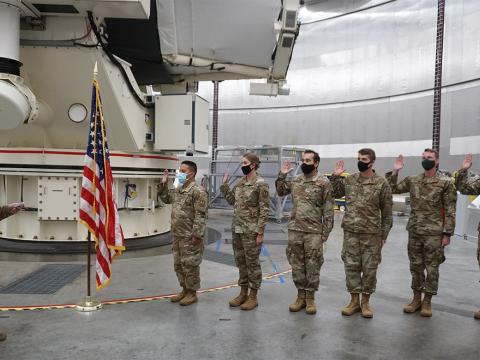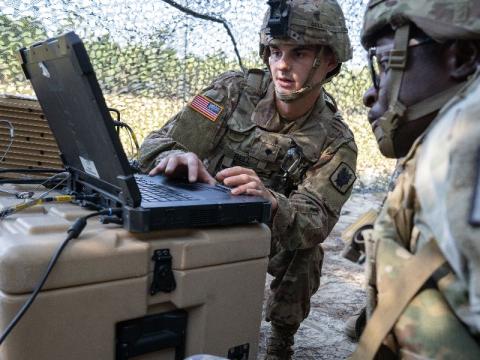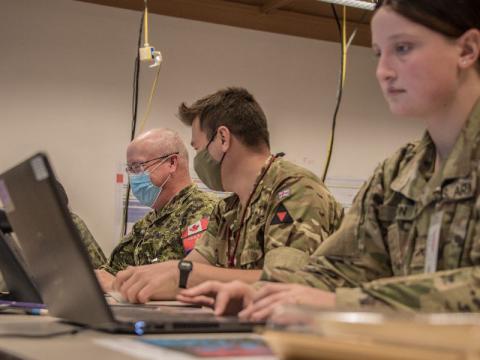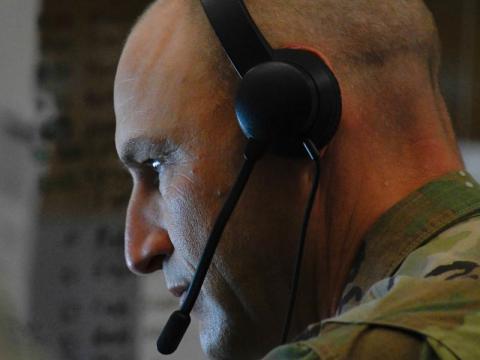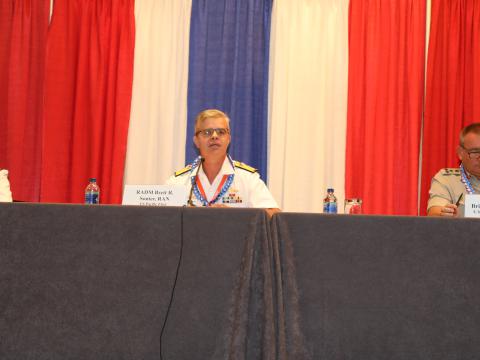Network Centricity Begins at Home
The Defense Department builds innovations from the ground up.
A new initiative by the U.S. Defense Department aims to speed the advent of network centricity by incorporating ideas directly from users. The result may be improved network centricity for small Defense Department components as well as new capabilities across the entire defense community.
Known as Rapid Acquisition Incentive Net Centricity, or RAI-NC, its objective is a fundamental change in the way the Defense Department does business. Its effects could reach from senior acquisition executives to the individual soldier in the foxhole. The program is funded with $110 million over the next six fiscal years, and the U.S. Navy’s eBusiness Operations Office is its executive agent.
Dr. Margaret Myers, principal director for the deputy chief information officer, Office of the Assistant Secretary of Defense for Network Integration and Information, describes the effort as a cultural change. “A lot of people are familiar with the phrase ‘knowledge is power.’ When you look at the heart of network centricity, it’s about showing people that sharing knowledge is power.”
Myers explains that the initiative emerged from a drive toward the network-centric business transformation of the department. This aspect of departmentwide transformation was not well fleshed out, she relates, and this need led to the RAI-NC pilot program thrust.
James E. Mulder, action officer in the office of the Defense Department’s deputy chief information officer, explains that the program is pursuing a dual thrust in its drive to implement network centricity throughout the department. It seeks to discover and incorporate new ideas for network-centric operations, and it also aims to institute a mindset of network centricity among all members of the defense community.
Mulder states that some of the successes that warfighters have enjoyed over the past year emerged from information management, services and systems; and these are determined by the ability to share information in a rapid, successful, reliable and secure fashion. Some of the network centricity goals include collaboration tools, “post before you process” and handling information only once, for example. Achieving these goals will require considerable up-front investment and intellectual involvement, he emphasizes.
“It’s all about getting the folks in the base, post, camp and station to be able to participate, provide their ideas and get involved in the next iteration of making the warfighter perform his mission better,” Mulder emphasizes. This includes making the Defense Department operate better by achieving the goals of network centricity that were laid out by Assistant Secretary of Defense for Network Integration and Information John P. Stenbit, he adds.
Accomplishing these tasks will take a multifaceted effort ranging from building a foundation at the network level to transforming culture and business processes, Mulder continues. Where the business management modernization program is focusing on some aspects of the business processes and establishing the architecture, several key elements fall outside of these domains. The RAI-NC effort will contribute strongly in the culture element and the lower-level business activities that have not been linked to those higher-level business domains, he offers.
“It provides proof of concept and quick demonstration of effective transformation in the various domains of the Department of Defense,” Mulder declares.
Myers notes that the acquisition process is not geared toward flexibility enabling transformational ideas. “Someone might have a good idea that you want to try out—coming out of the sun might be some project, some investment that everyone says, ‘Wow, what a great idea. We ought to have one of those departmentwide,’” she offers. “Some of these ideas will be things that will tend to be smaller items, such as applications that you can download from a Web site and install, and it doesn’t require a lot of formal support. You really want to be able to turn inside the technology cycle, and we all know that it is difficult to do that with a formal acquisition program.”
The RAI-NC program is designed to encourage initiatives based on enterprise interoperability, enterprise business processes and enterprise architectures. Mulder explains that many of the base/post/camp/station users do not have the latest information about those three aspects, nor may they be up to date on how the Defense Department enterprise fits into the federal government enterprise.
The RAI-NC would allow these users to submit process-change ideas that would help develop business cases for broader transformation and departmentwide changes. “Not only does this help to get the word out, but it also helps to infuse new ideas at the inside-the-beltway level,” Mulder declares.
At the heart of the RAI-NC are pilot programs that would last from six to 12 months. Defense components would submit proposals for these pilots, which would then be judged by program officials for selection and implementation. When the effort is fully ramped up, the RAI-NC may encompass as many as 20 pilot programs per year.
“If we can provide a pilot in six months or less that shows the potential of great return—within the bounds of the enterprise architecture and interoperability that’s going on—the benefits will show that the investment was well made,” he warrants.
As an example, an individual with an idea about a network-centric concept would propose the development of a pilot program that would offer proof of concept in a short time frame. A Web page permits online submittal of applications. This includes the selection criteria that will help determine the first round of pilot programs. The goal is to identify and develop activities that would work across the multiservice spectrum of Defense Department users.
This individual would apply through his or her defense component. That component and its chief information officer (CIO) would be involved in the submission to ensure that the pilot idea would fit into the domain owner’s and the CIO’s plans. For example, a localized pilot program that aimed at improving how network centricity could provide ammunition to the front more efficiently would include the logistics domain owner both for the component and at the Office of the Secretary of Defense (OSD) level.
“There are a lot of smart people who work for the Defense Department who have good ideas, and those good ideas don’t always make it to the Pentagon,” Myers observes. “This is a way to help surface some of those good ideas that might not otherwise get implemented.”
Pilot program applications will be accepted only from Defense Department components—“dot-mil or dot-gov addresses,” Mulder states. Commercial entities that want to participate cannot submit suggestions on their own. They must work through their Defense Department component, which is responsible for the application.
The process involves more than just a quick online application for a pilot program, Mulder points out. After the application is submitted, the Navy executive agent works with the submitter to define and refine the pilot program proposal. The program is striving for ideas that are more than merely plans to buy more collaboration tools, for example.
“Our goal is not to just do pilots that are not interconnected or integrated, but it is to define pilots that have business cases associated with them and will be able to show that they are scalable across the department,” Mulder states.
Similarly, Myers notes the difference between just requesting funding for a program and actually launching a change. “We’re not looking for somebody who comes along and says, ‘Well, you know, if I had a few bucks I could automate this process.’ We’re more after getting people to look at how they share and use information—and protect it too—as opposed to building systems.
Mulder expects that the program will receive submissions ranging from small base-unique solutions to OSD-level business architecture efforts. He notes that he already has received inquiries from more than half a dozen headquarters-level components seeking information about the process.
After the executive agent processes the list of applicants, the list will be submitted to Mulder’s office ranked by a pre-determined weighting and scoring system. The CIO office will work with the domain owners and CIOs to select the final pilot programs.
When a pilot program is completed, an opportunity analysis will provide a detailed look at the pilot’s progress and how it met its defined goals—or not. Scalability would be part of the exit criteria, Mulder adds. “One of the reasons we are trying to include the domain owners in all of these [steps] is that, as the pilot proceeds and the domain owner has that visibility, then this owner could begin to look at out-year programming and how that fits within their plans, the business processes that they are changing and the architecture that they are working on.
“Potentially, by the time the pilot is over, that domain owner could see that it is a very valuable thing and thus begin the planning of the transition from pilot to operationalizing,” he says. “Whether it becomes operational or a lesson learned, that’s their choice.”
The program begins with $10 million in funding for fiscal year 2004, which then rises to $20 million per year from 2005 through 2009.
New Internet Protocol Fuels Defense Network Changes The U.S. Defense Department has committed to employing the newest Internet protocol (IP) in its Web-centric activities. Known as IP version 6, or IPv6, the protocol already is in use in some parts of the Internet. The Defense Department decision establishes that the department will commit its future Internet activities to adopt IPv6 departmentwide by 2008. In announcing the commitment, Assistant Secretary of Defense for Network Integration and Information John P. Stenbit cited the department’s transformation toward network-centric activity as a driver in this change. The heart and soul of the U.S. Army’s future combat system (FCS) program, for example, is network-centric operations, and other programs also will be affected directly. “It’s really important that the programs that move forward—and in particular ones such as FCS and laser communications satellites—are able to face a certain world about the crucial issues of the network with which they will have to interface,” Stenbit says. “We believe that the evolution of the IPv6 debate has moved far enough along so that some people deliver hardware and software that are compatible with both standards,” Stenbit offers. “We need to make clear to our major development activities that will come on line in the 2008-2010 time frame that the IPv6 standard, as it evolves, is what we will be using as a department standard.” Stenbit notes that the Internet has operated on IPv4 for about 30 years. Issues that have arisen over the years traditionally have been addressed by commercial fixes or appliqués. The new version addresses many of the key issues that still plague IPv4, some of which are crucial to the Defense Department. These include improved end-to-end security and quality of service. Stenbit explains that, in a network-centric world, end-to-end security is achieved differently than in today’s link-centric world. The current type of sender-centric encryption works only if that sender knows that the person on the other end has the appropriate encryption system. Networking does not always permit that approach, so the packet itself must include the crypto. For quality of service, under IPv4 a packet may be sent via the Internet with no guarantee that it will reach its proper destination. Being able to tag some packets to travel with other groups to ensure arrival is important to the Defense Department, Stenbit states. IPv4’s shortcomings are driving a commercial push toward IPv6, especially in Europe, Stenbit notes. By 2008, IPv6 should have attained commercial dominance, which is one of the reasons that the Defense Department has set that year as its target. Another reason for that date is that 2008 is in the time frame when programs that are beginning now start to come to fruition, he says. In addition to mandating that future IP systems operate on IPv6, the Defense Department is going to transition three systems to the new standard as pilot programs. The first chosen will move to IPv6 in 2005, with the next two following in 2006 and 2007. Among those under consideration are the nonsecure Internet protocol router network (NIPRNET) and the Navy/Marine Corps Intranet (NMCI), for example. Updates and refreshes could be mandated to switch those systems over to IPv6. The Defense Department’s commitment to IPv6 affects both what the department will do with its intranets and how it interfaces with the Internet, Stenbit emphasizes. |



